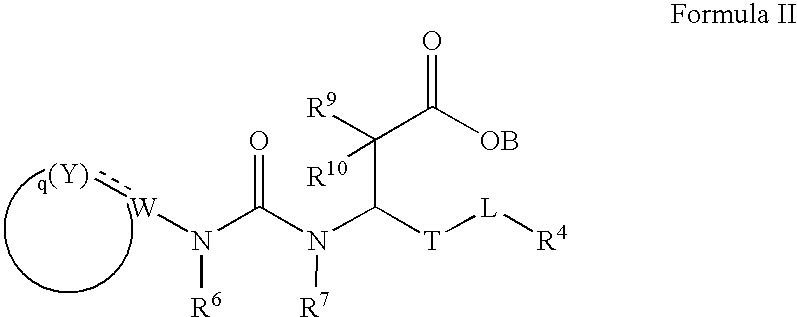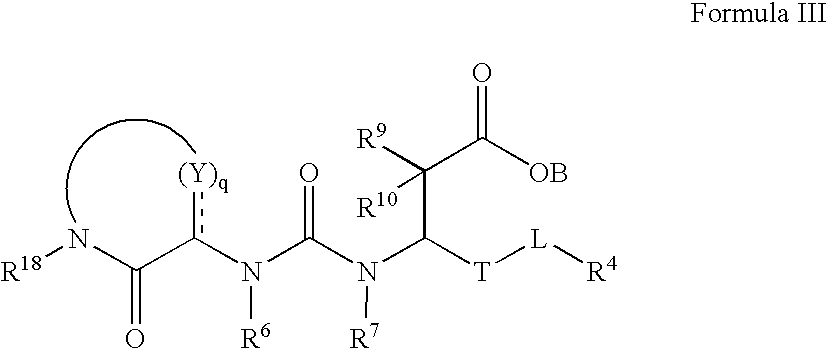Carboxylic acid derivatives that inhibit the binding of integrins to their receptors
- Summary
- Abstract
- Description
- Claims
- Application Information
AI Technical Summary
Benefits of technology
Problems solved by technology
Method used
Image
Examples
example 1
Synthesis of (3S)-3-{[({1-[(2-chlorophenyl)methyl]-4-ethyl-2-oxo-1,2-dihydro-3-pyridinyl}amino)carbonyl]amino}-3-(4-methylphenyl)propanoic acid (10)
[0228]Step One: Compound 1 (20.8 g, 135 mmol) was dissolved in methanol (270 mL) and palladium on carbon (10% Pd dry weight basis, Degussa type E101 NE / W, ˜50% water content, 5.75 g, 2.7 mmol Pd) was added. The atmosphere was replaced with hydrogen (toggle between vacuum and hydrogen from a balloon five times), the mixture was stirred overnight, then filtered. The filtrate was concentrated under vacuum and the residue was taken up in a 1:1 hexanes:ethyl acetate mixture and washed with a 4:1 mixture of water and saturated NaHCO3, saturated NaHCO3 and brine. The organic layer was dried over MgSO4 and filtered and the filtrate was concentrated under reduced pressure to give compound 2 (12.43 g, 74%) as a white solid. This material was used without purification.
[0229]Step Two: Compound 2 (2.64 g, 21.3 mmol) was dissolved in dichloromethane (...
example 2
Synthesis of (3S)-3-{[({6-methyl-2-oxo-1-(phenylmethyl)-4-[(phenylmethyl)oxy]-1,2-dihydro-3-pyridinyl}amino)carbonyl]amino}-3-(4-methylphenyl)propanoic acid (15)
[0236]Step One: To a suspension of compound 11 (1.0 g, 5.9 mmol) and K2CO3 (2.40 g 17.6 mmol) in acetone (50 mL) was added benzylbromide (2.31 g, 13.5 mmol). After refluxing overnight, the reaction was cooled and the mixture was partitioned between ethyl acetate and saturated NaHCO3. The organic layer was washed with dilute HCl and brine, dried over MgSO4 and filtered and the filtrate was concentrated to give compound 12 (1.60 g, 80%).
[0237]Step Two: Compound 12 (0.30 g, 0.86 mmol), zinc powder (0.30 g, 4.6 mmol) and saturated aqueous NH4Cl (0.30 mL) were mixed in MeOH (18 mL). This mixture was allowed to stir at room temperature for 1 hour before additional zinc (0.30 g, 4.6 mmol) was added. The resulting heterogeneous mixture was refluxed overnight. After filtration of the hot mixture and concentration of the filtrate unde...
example 3
Synthesis of (3S)-3-{[({4-amino-1-[(2-chlorophenyl)methyl]-6-methyl-2-oxo-1,2-dihydro-3-pyridinyl}amino)carbonyl]amino}-3-(4-methylphenyl)propanoic acid (22)
[0240]Step One: To a solution of compound 11 (10.00 g, 58.8 mmol) in anhydrous DMF (120 mL) at 0° C. was added NaH (60% dispersion in mineral oil, 5.40 g, 135 mmol). The mixture was stirred at 0° C. for 15 minutes before the addition of 2-chlorobenzylchloride (12.3 g, 76.4 mmol). After stirring at 55° C. overnight, the mixture was poured into ice-water and washed with Et2O twice. The aqueous layer was acidified and filtration of the resulting precipitate gave compound 16 (14.7 g, 85%).
[0241]Step Two: To a flask containing compound 16 (8.00 g, 28.6 mmol) sealed with a rubber septum and balloon at room temperature under dry nitrogen atmosphere, POCl3 (30.0 ml, 322 mmol) was added via syringe. The nitrogen line was removed and the reaction mixture was stirred overnight at 70° C., then poured over ice (300 ml) and stirred for 30 min...
PUM
| Property | Measurement | Unit |
|---|---|---|
| Electrical conductance | aaaaa | aaaaa |
| Molar density | aaaaa | aaaaa |
| Molar density | aaaaa | aaaaa |
Abstract
Description
Claims
Application Information
 Login to View More
Login to View More - R&D
- Intellectual Property
- Life Sciences
- Materials
- Tech Scout
- Unparalleled Data Quality
- Higher Quality Content
- 60% Fewer Hallucinations
Browse by: Latest US Patents, China's latest patents, Technical Efficacy Thesaurus, Application Domain, Technology Topic, Popular Technical Reports.
© 2025 PatSnap. All rights reserved.Legal|Privacy policy|Modern Slavery Act Transparency Statement|Sitemap|About US| Contact US: help@patsnap.com



